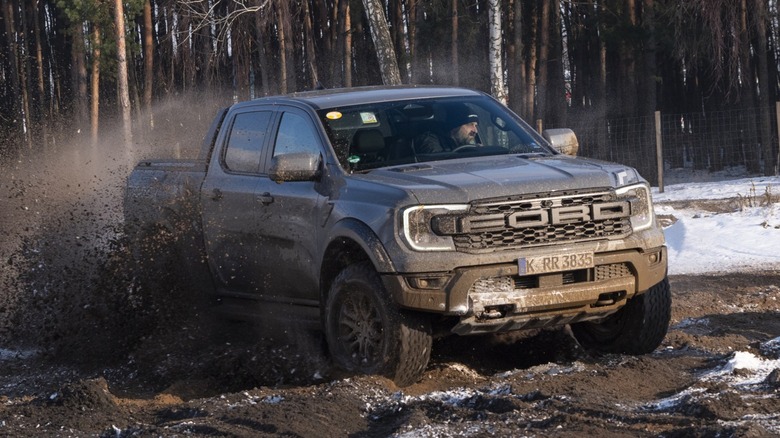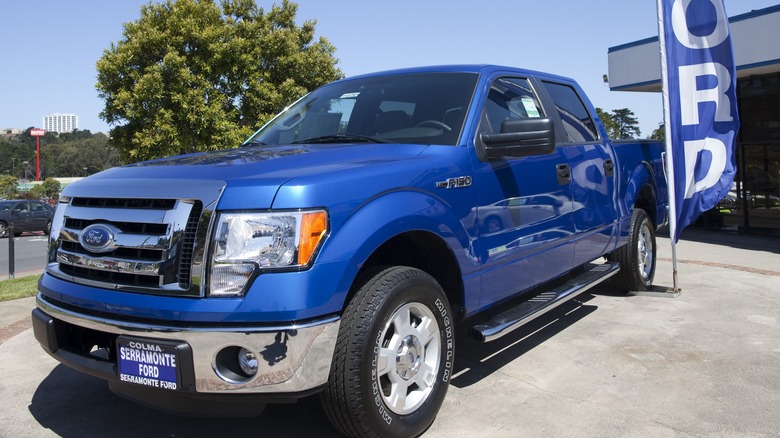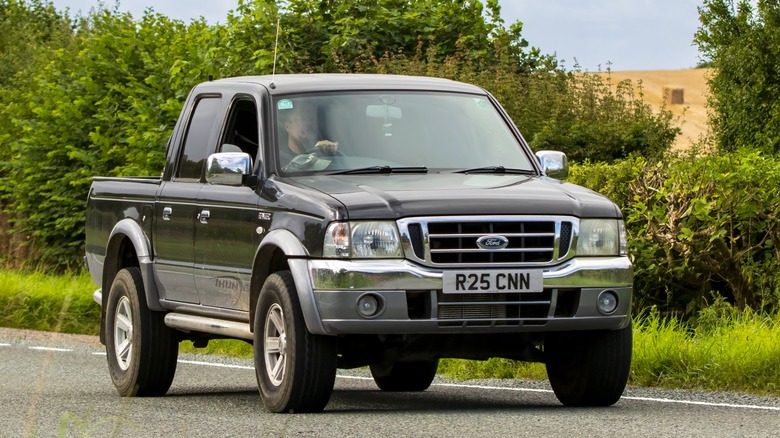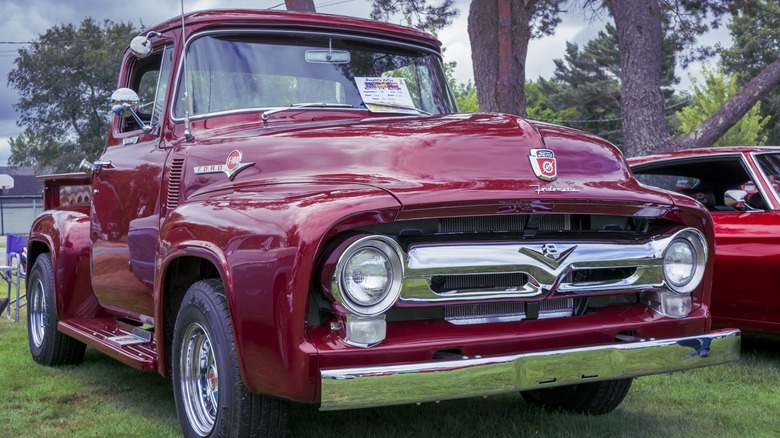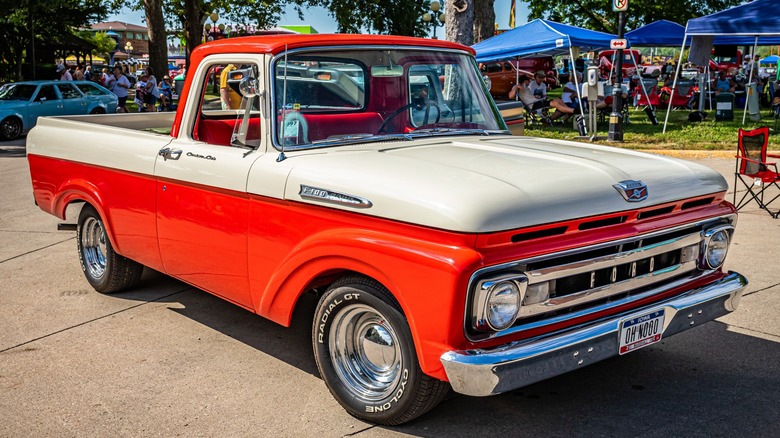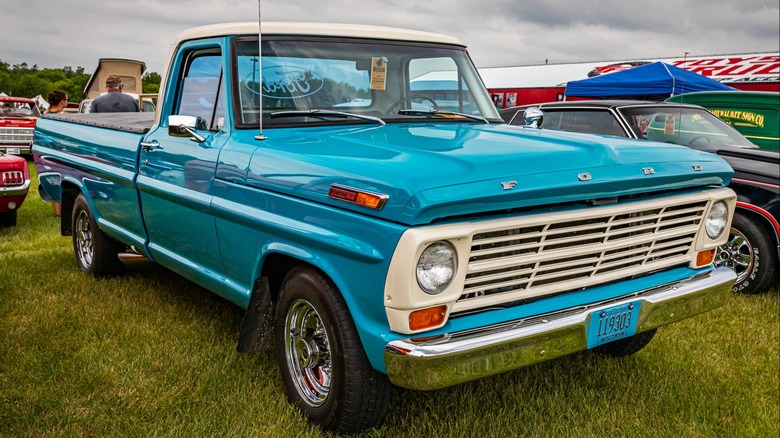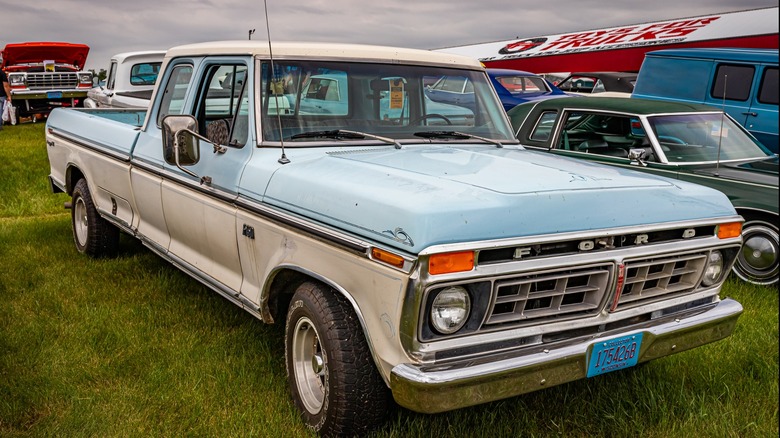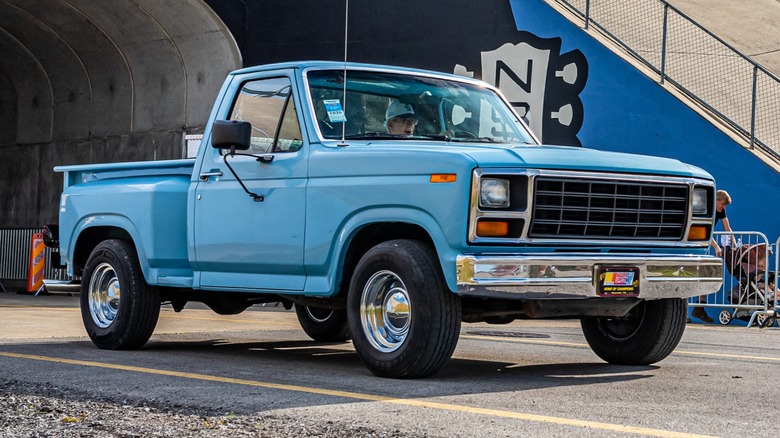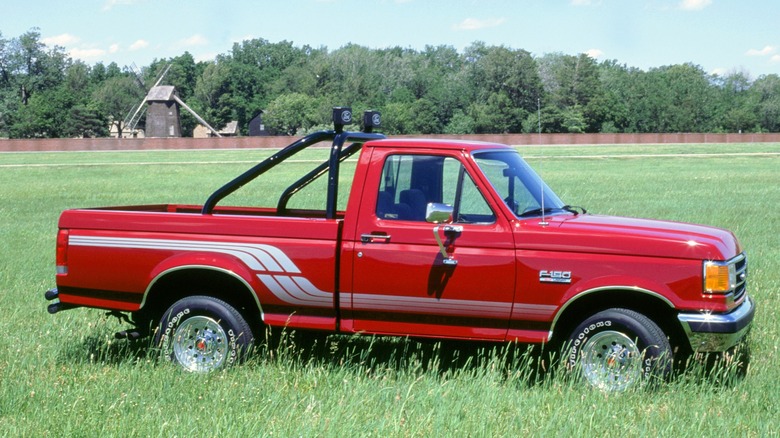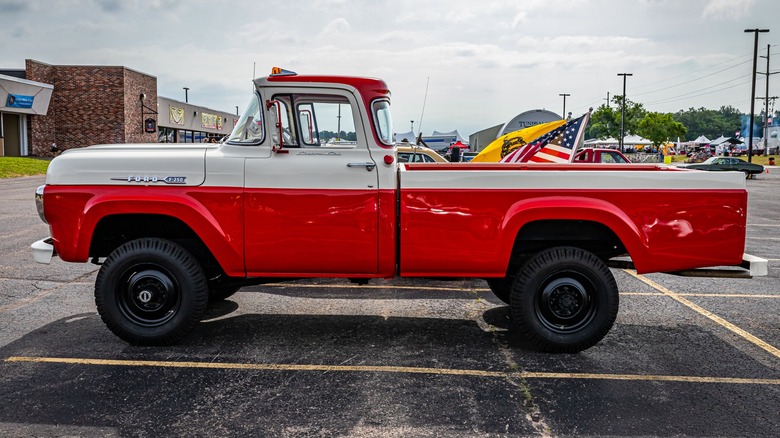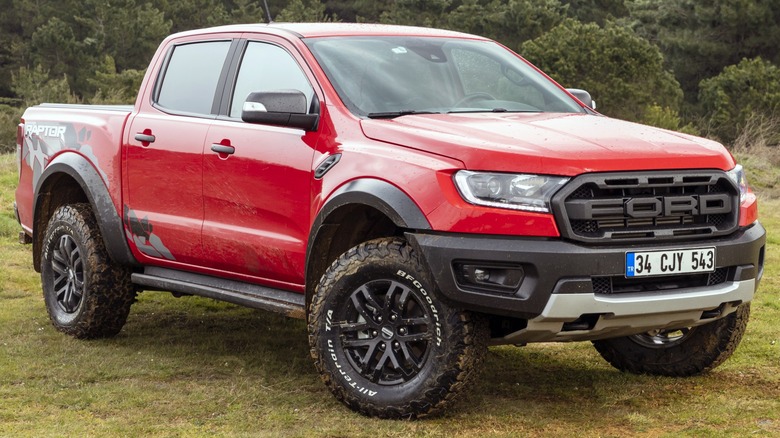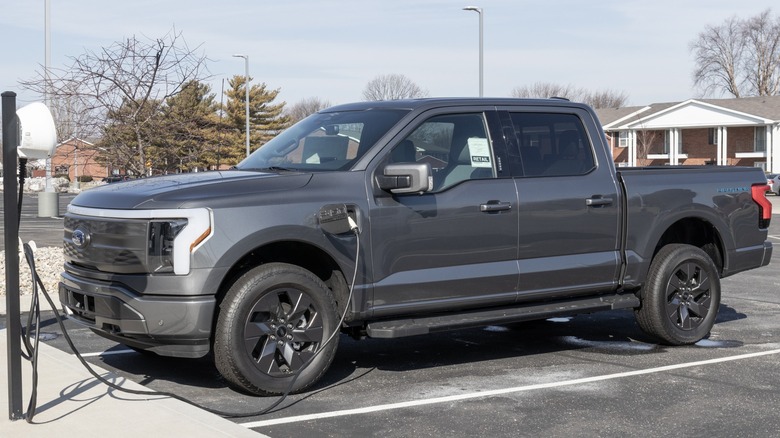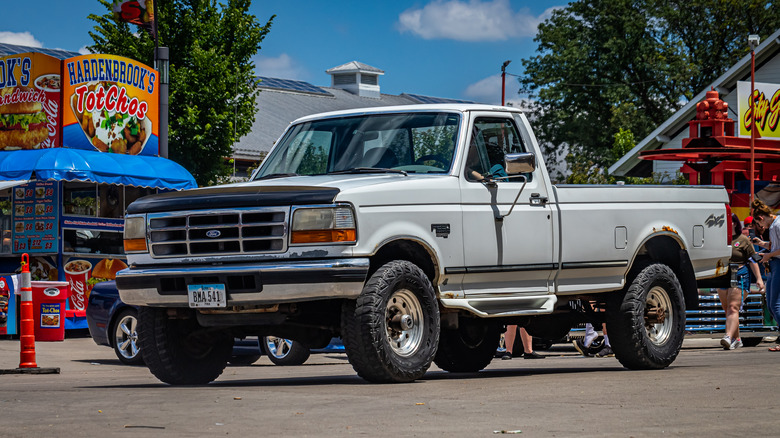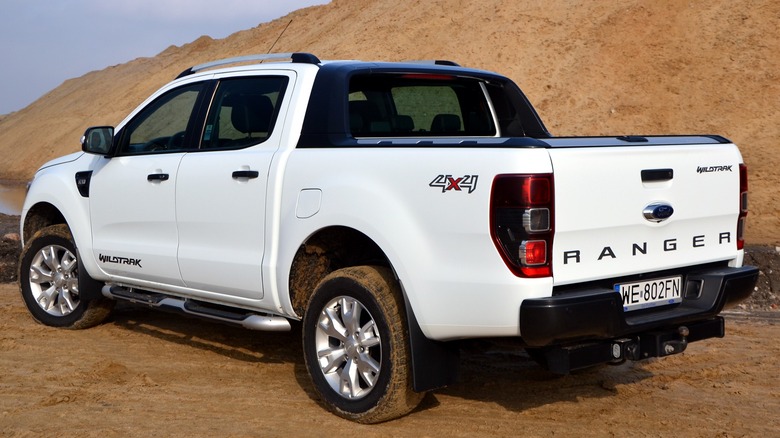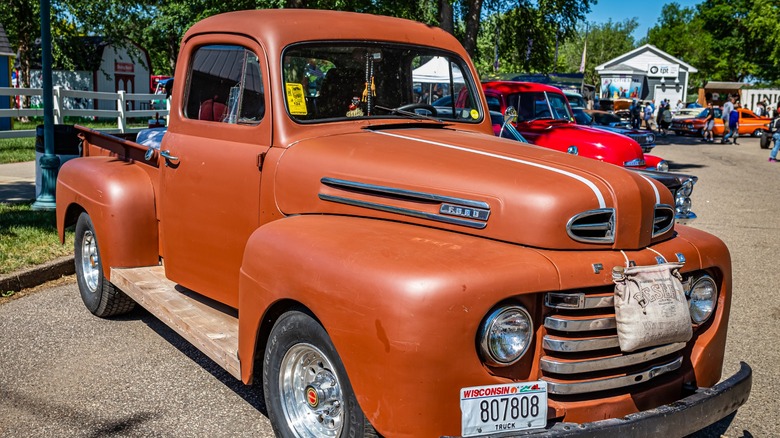Every Generation Of Ford's F-Series Ranked Worst To Best
For nearly 75 years, Ford Motor Company has led the pickup segment of the automobile industry with its F-Series trucks. Through technological innovation, quality construction, and exceptional reliability, the automaker has consistently offered buyers one of the best options for hauling, towing, off-roading, or riding comfortably in a daily-use vehicle. Over several generations, Ford implemented new designs or technologies that influenced future F-Series generations and had a significant impact on the pickup truck industry. Some of these include:
V8 engine: Ford introduced a V8 engine in the F-Series trucks in 1948, and in 1954, the automaker implemented the Y-block overhead valve 239-cubic-inch V8. The original engine remained in service through 1962.
Twin-I-Beam suspension: Ford introduced the independent front suspension with stable geometry to improve handling and provide a much smoother ride than traditionally offered in a pickup truck. The Twin I-Beam design is still used today in Ford's 3/4-ton and 1-ton trucks.
Four-wheel-drive: Although Ford did not offer four-wheel-drive systems on its pickup trucks until 1959, when it did, the enhanced capability opened new opportunities for owners. Hauling and towing tasks became less challenging, and it raised the limit for weekend off-road adventurers out to tackle rough terrain.
Here is a ranking of Ford's F-Series truck generations based on innovation as the principal criteria, starting with the worst (or, more accurately, the least innovative) to the best (most innovative).
Ford F-Series tenth generation (1997-2004)
Ford made major changes to the F-series for the tenth generation, including a new chassis, a softer shape, and creature comforts that were previously only found in the SUV. The automaker sought to market the F-150 to casual users, those seeking a daily driver more than a workhorse for hauling loads. The sleek, aerodynamic design used a lighter chassis that replaced the twin-I-beam front suspension with a torsion-bar setup. The F-250 and F-350 Super Duty models were focused on features required for heavy hauling and commercial applications.
Perhaps the highlight of the tenth-generation F-Series was the re-introduction of the SVT Lightning in 1999. The new version boasted an Eaton Gen IV supercharged, liquid-to-air intercooled, 5.4L V8 engine fitted with forged-steel pistons and crankshaft, mated to a heavy-duty 4R100 four-speed automatic transmission. The powerplant generated 380 horsepower and 450 foot-pounds of torque, making the SVT Lightning the most powerful production passenger vehicle sold in the U.S. at the time. Car and Driver test results showed an acceleration from 0 to 60 mph in 5.2 seconds and a top speed of 142 mph.
However, the 2004 Ford F150 suffered from a high number of engine failure complaints and faulty gas tank straps, resulting in an NHTSA recall (campaign number #11V385000). More than a million trucks were at risk of a corroded component that caused the gas tank to detach from the undercarriage of the truck, making it one of the least reliable Ford pickups ever produced, and the tenth generation the worst in the history of F-Series trucks.
Ford F-Series eleventh generation (2004-2008)
For the eleventh generation, Ford continued to evolve the F-150 into a vehicle with comfort features typically found in cars, but with a pickup truck's cargo space. A superior interior, a more forgiving ride, and improved handling appealed to the growing number of buyers who wanted to use pickups as a primary vehicle.
Ford offered the eleventh-generation F-150 with several engine options. A 4.2-liter V6 producing 202 hp and 260 lb-ft of torque was available starting with the 2005 model year. The two V8 engine options included a 4.6-liter with two valves per cylinder that generated 231 hp and 293 lb-ft of torque for the 2004-2006 model years, but produced an improved 248 hp and 294 lb-ft of torque through 2008. The other V8 option, a 5.4-liter with three valves per cylinder, produced 300 hp and 365 lb-ft of torque. Ford connected all the engines to four-speed automatic transmissions but offered a five-speed manual transmission as an option on the V6.
Power was sent to the rear wheels as standard, but buyers could select 4WD drivetrains. Ford found the extra weight of the 4WD system significantly degraded the performance of F-150 models equipped with the V6, so it discontinued the option after the first year. However, even the rear-wheel drive version powered by the 4.6-liter V8 produced disappointing performance results, accelerating to 60 mph in 9.6 seconds and reaching a top speed of 130 mph.
Ford F-Series second generation (1953-1956)
Ford changed its naming system for the Ford F-Series with the 1953 model, but more significant were the creature comforts added to the cab and the replacement of the celebrated flat-head V8 in 1954 with the 239-cu.in. OHV Y-Block V8. The new engine, with a 7.2:1 compression ratio and a two-barrel carburetor, produced 130 hp and 214 lb-ft of torque. Ford offered a manual transmission in three configurations: a three-speed on the column, a three-speed with overdrive, or a floor-shifted four-speed. The automatic transmission was optional.
Although Ford made modifications to the light-duty trucks in later generations to make them more appealing to the daily driver, the company had already begun the process in the second generation. Ford widened the front-end body panels, creating a more aggressive look while maintaining its passenger car's modern style. Driver and passenger visibility was improved with an increase in the size of the windshield (by 55 percent) using curved glass, and a new rear window that stretched the full width of the cabin.
To reduce driver fatigue, typical of pickup trucks in the early '50s, the automaker made the cab more passenger-friendly. A five-foot-wide seat and more interior space for its occupants made the standard cab more comfortable. Buyers could also choose the Deluxe cab option, including foam seat padding, a headliner, driver and passenger armrests, sun visors, a dome light, a cigar lighter, and chrome vent window moldings. The second-generation Ford F-series truck has become a favorite of hot rodders, and today, customized models fetch between $30,000 and $50,000.
Ford F-Series fourth generation (1961-1966)
Although Ford introduced a novel "unibody" design with "styleside" or fleetside truck beds in 1961 that eliminated the gap between the cabin and the bed, the change was short-lived. The design enhanced the appearance of the truck and the continuous piece of sheet metal from the cab to the back of the bed made it less expensive to produce. However, several issues prompted Ford to discontinue the design for the 1964 model year. When the truck hauled a heavy load, the body flexed, causing the doors to jam and remain closed.
Arguably one of the most innovative designs in the history of the F-Series trucks, Ford introduced the twin-I-beam suspension in 1965. The automaker promoted the new independent front suspension that replaced the traditional solid-axle setup with the slogan, "Drives like a car, works like a truck."
Before the change, pickup trucks were built with stiff suspensions designed for hauling heavy loads over uneven roads. While drivers who needed a truck for work tolerated the rough ride, a new category of pickup truck owners wanted a vehicle for occasional hauling and towing, but with the smooth ride of a passenger car for daily use. The independent design of the twin-I-beam system provided the solution. Ford removed the front leaf springs, replacing them with a coil-spring mechanism fitted with larger shock absorbers. Handling was improved, with more axle control and better traction, while the system absorbed the impact of road bumps for a smoother ride.
Ford F-Series fifth generation (1967-1972)
Ford completely restyled the new F-100 for the fifth generation that began with the 1967 models and, except for a few minor grille and trim upgrades, remained through 1972. Ford engineers made the cab and the hood wider. The flat grille was made, with four columns of stamped slots bordered by the headlights at each end. The trucks of this era are often referred to as the "Bumpside" pickups due to protruding ridges or "bumps" that run along the truck's body from the front to the rear. The ribs added strength to the body panels and gave the pickup a distinctive look.
On the interior, Ford added more luxury features typical of those found in cars. The upgrades reflected the trend toward building light trucks for daily driving and recreation as well as hauling and towing. Ford fitted the fifth-generation trucks with improved sound insulation for a quieter ride, more shoulder room, a heater, lap seatbelts, updated armrests, interior door handles, and two-speed windshield wipers as standard equipment. Options included power steering, power brakes, air conditioning, AM radio, and shoulder seatbelts.
Beginning in 1967, Ford offered the pickup in Standard Cab, Custom Cab, and Ranger trim levels, all with the same drivetrain and bed options. Buyers could select an inline six-cylinder engine or the 352-cubic-inch "Interceptor" V8, producing 208 hp and 315 lb-ft of torque. In 1968, the automaker replaced the 352 ci V8 with a 360 ci and 390 ci V8 producing 215 hp and 255 hp, respectively.
Ford F-Series sixth generation (1973-1979)
Three major factors impacted the design of Ford F-series trucks in the late 1970s. The OPEC oil embargo resulted in quadrupled gas prices that doomed large-displacement V8 engines. New, strict emissions standards deflated horsepower and performance. And buyer demand for pickups with comfort features that made them a viable option as daily drivers increased. The introduction of the Ford F-150 in 1975 highlighted the sixth-generation F-Series, demonstrating the influence of these issues on vehicle design and development.
The F-150 boasted a higher gross vehicle weight (6,050 pounds) than its sibling, the F-100. The heavier rating exempted the truck from some federal emissions standards, including the use of a catalytic converter and unleaded fuel. It also allowed the continued use of the naturally aspirated big-block V8 engines. Ford also avoided EPA regulations with the launch of the heavy-duty long-wheelbase F-350 in 1973, with an even heavier payload capacity.
Ford offered several trim levels across the F-100, F-150, F-250, and F-350 models. The Ranger was the most luxurious, with features found in a typical Ford sedan. Without the requirement for a catalytic converter, the F-150 was available with all of Ford's engines, including the 300-cubic-inch six that replaced the 240-cubic-inch engine and the 460-cubic-inch V8. Still, the impact of higher gas prices was evident in engine output. A 400-cubic-inch small-block produced only 169 hp, and a 351-cubic-inch version cranked out 160 hp.
Ford F-Series seventh generation (1980-1986)
When Ford offered its first factory-built F-Series diesel pickup truck in 1983, it was powered by an International Harvester 6.9L IDI diesel engine that produced 150 horsepower and 285 lb-ft of torque, or an optional engine generating 170 horsepower and 315 lb-ft of torque. Ford offered the diesel engine in its F-250 and F-350 trucks as an alternative to the 7.5L 460 engine through the 1987 model year.
While Ford forged new ground with the introduction of diesel-powered F-Series trucks, the automaker experienced robust sales over the complete F-Series truck line. In 1980, Ford sold 173,050 F-150s and 133,590 of the base F-100 pickups. However, in the early 1980s, domestic auto companies faced stiff competition for all their models from overseas. Consumers perceived imports as higher quality, more fuel-efficient, and less expensive than their American counterparts. Although the F-150 was the best-selling vehicle, Ford decided a new campaign was needed to remind buyers that American-made vehicles were built with high quality as well. The company adopted the slogan at Ford, "Quality is Job 1."
At the end of 1983, Ford discontinued the F-100, making the F-150 the base model. The 1984 F-150 was offered in four trimlines — base, XL, XLS, and XLT Lariat, each of which could be configured with one of three engine options. The straight six-cylinder produced 115 hp, while the 302-cubic-inch V8 engine produced 130 hp, and the 352-cubic-inch engine generated 150 hp. Ford offered all the models with a manual or automatic transmission and either a rear-wheel or four-wheel drive.
Ford F-Series eighth generation (1987-1991)
During the eighth generation of the Ford F-Series, all engines migrated to electronic fuel injection (EFI), marking the end of carbureted engines in the automaker's pickup truck line. An EFI system is composed of an Electronic Control Unit (ECU) and several sensors such as the Throttle Position Sensor (TPS), Manifold Absolute Pressure (MAP) Sensor, Mass Air Flow (MAF) Sensor, and others that are used to instantaneously determine the ideal amount of fuel. The ECU reads engine RPM and information from the sensors to meter the fuel, adjusting the fuel pump and ignition timing.
In 1987, Ford offered the 1/2-ton F-150 in both regular cab and extended cab body styles, either with RWD or 4WD. The base model was fitted with a fuel-injected 300-cubic-inch six-cylinder that produced 145 hp and 265 lb-ft of torque. Ford still offered the 302-cubic-inch V8, but for the eighth generation, the automaker made the fuel-injected 5.8L high-output F-250 engine available in the F-150. The powerplant generated 210 hp and 305 lb-ft of torque. In 1987, a four-speed manual transmission was standard, but beginning in 1988, Ford made the five-speed manual standard and an automatic optional.
The eighth-generation F-Series trucks with base Custom, mid-range XL, and top-of-the-line XLT Lariat trim levels carried over much of the body style from 1980s models. However, minor changes featured a modern flat grille, flush headlamps replacing the sealed-beam headlights, and rounded wheel arches. The trucks included power steering, power brakes, and ABS brakes as standard equipment.
Ford F-Series third generation (1957-1960)
Although third-party 4x4 conversions had been available on Ford F-Series trucks for several years, 1959 marked the first year the automaker offered it as a factory option. Many of today's new pickup truck buyers consider the four-wheel drive a "must-have" feature on a Ford F-series. Not only does it enhance the truck's hauling and towing capabilities, but it also allows drivers to venture just about anywhere off-road.
Ford's changes to the F-series' exterior for the third generation featured a wider, squared-off style. The larger cabin provided more space inside, and the flatter hood demonstrated a clamshell design. The new F-Series pickups also introduced the "Styleside" body that provided a more streamlined appearance and more space than the big-fendered look, with a split cabin-and-bed design. Although briefly discontinued, the style became a standard that remains to this day.
Ford offered the 1957 F-100 with two engine options: The 223-cubic-inch straight-six, producing 139 hp and 207 lb-ft of torque, and the 272-cubic-inch V8, generating 171 hp and 260 lb-ft of torque. However, in 1958, the Y-block 272 was first given a horsepower boost and later replaced with the 292-cubic-inch V8. All the engines were mated to a three- or four-speed manual transmission or a three-speed automatic. Today, the chunky style of the third-generation Ford trucks has gained popularity with collectors and hot rodders. The vehicles are simply built, with plenty of aftermarket parts available, making them ideal for customization. Resale prices vary from $17,000 for a stock model to nearly $50,000 for restored versions.
Ford F-Series thirteenth generation (2015-2020)
Ford initiated the F-Series thirteenth generation with a significant change in materials. The trucks were built with extensive use of aluminum, featuring a mostly aluminum body mounted on a traditional steel frame. The new body was much more rust-resistant than those made of steel, and weighed less. The 750 pounds of weight saved meant the truck performed better and was more fuel-efficient than the previous year's heavy models.
In 2018, Ford introduced a new base engine, the F-150 direct-injected 3.3-liter V6 engine, replacing the aging 3.5-liter V-6. The dual ports and direct injection boosted power and torque. The 3.3-liter V6 generates 290 hp and 265 lb-ft of torque (eight more hp and 12 more lb-ft of torque than the outgoing 3.5-liter V-6). In the same year, the automaker also offered a diesel engine for the F-150, based on the Lion turbodiesel 3.0-liter V-6.
In 2020, Ford offered the Super Duty line with XL, XLT, Lariat, King Ranch, Platinum, and Limited trims, each with three engine options. The gas-powered mills included a 6.2-liter V8 producing 385 hp at 5,750 rpm and 430 lb.-ft. of torque at 3,800 RPM and the 7.3-liter V8 generating 430 hp at 5,500 rpm and 475 lb.-ft. of torque at 4,000 RPM. The third engine option was the new Power Stroke 6.7-liter diesel V8 that cranked out 475 hp and a whopping 1,050 lb-ft of torque. The most powerful engine in the Super Duty line, it gave the diesel truck up to a 37,000-pound towing capacity.
Ford F-Series fourteenth generation (2021-present)
Although Ford has dominated the pickup truck market since the introduction of the first-generation F-Series, competition from improving Ram, Chevrolet Silverado, and other models has inspired the automaker to maintain a margin of technology and performance superiority to stay ahead of its competitors. Two recent innovations are the PowerBoost Hybrid and the F-150 Lightning EV, both introduced in 2021.
The Hybrid is equipped with a 3.5L twin-turbo DOHC 24-valve V-6 producing 394 hp and 492 lb-ft of torque, and an electric motor generating 44 hp and 221 lb-ft of torque. The pickup generates a total of 430 hp and 570 lb-ft. The four-wheel-drive Hybrid is rated at 24 mpg by the Environmental Protection Agency (EPA) and can travel up to 624 miles before refueling. Although the Ford F-150 is stingy on gas consumption, the pickup also boasts impressive performance, accelerating to 60 mph in 5.3 seconds.
The Ford F-150 Lightning offers buyers a full-size four-wheel-drive light-duty truck powered by dual permanent-magnet synchronous AC electric motors. Although the Lightning has many of the standard (gas-powered) F-150 features, it is limited by a range of 240 miles (EPA-estimated). However, the Extended Range model with a larger battery has a maximum driving range of 320 miles. The Lightning boasts an acceleration of 0 to 60 mph in 4.0 seconds, but the towing capacity, rated at 7,700 pounds, ranks low in its class. Of course, Ford still offers the conventional-fuel-powered F-150, as well as the muscular Ford F-150 Raptor, made for the off-roading enthusiast.
Ford F-Series ninth generation (1992-1997)
A redesigned ninth-generation F-Series truck demonstrated a smoother, more modern appearance than previous generations, using the same chassis and cab but with updated tech. Robust sales of the ninth-generation F-series helped the pickup set sales records. In 1995, the pickup became the world's best-selling vehicle, exceeding the Volkswagen Beetle (although the Beetle remained the best-selling passenger car).
However, the highlight of the generation was the introduction of the high-performance F-150 Lightning in 1993 and later the SVT version. The truck was powered by a naturally aspirated 5.8-liter V8 producing 240 hp and 340 lb-ft of torque. The engine featured cylinder heads that combined with a new "Special Vehicle Team" SVT-only, tubular aluminum intake manifold. Hypereutectic aluminum alloy and silicon pistons, a roller camshaft, a wide 65mm throttle body, and a dual-exhaust system also contributed to the F-150 Lightning's performance. The pickup truck accelerated from 0 to 60 mph in 7.2 seconds, reaching the quarter mile in 15.6 seconds.
Excellent performance and handling typical of a high-performance sports car were provided by a sport-tuned suspension featuring twin I-beams up front and special front coil and rear leaf springs, 25.4mm front and rear sway bars, and Monroe Formula GP shock absorbers. Stopping power was achieved with 11.72-inch front discs and 11.03 x 2.25-inch-wide ABS rear drum brakes. The truck rode on 17 x 8-inch, cast-aluminum, five-spoke wheels with Firestone Firehawk P275/60HT-70 radial tires.
Ford F-Series twelfth generation (2009-2014)
The Ford F-Series twelfth generation saw two significant milestones in the history of the automaker's pickup trucks. In 2010, Ford introduced the F-150 Raptor, perhaps the best off-road production truck ever made. In 2011, the company also offered buyers an alternative to a V8 engine with the 3.5-liter EcoBoost V6. It was the most powerful engine available in the F-150 lineup at the time, offered the highest towing capacity, and had the best gas engine fuel economy.
Ford equipped the first Raptor with an SOHC 5.4-liter V8 that produced 320 hp but upgraded to the 411-hp 6.2-liter V8 shortly thereafter. For the second generation, the automaker replaced the naturally aspirated V8 with the high-performance EcoBoost V6, generating more power at 450 hp and 510 lb-ft of torque. While the Raptor's power competed well with Chevy, GMC, and Ram pickup trucks of the its era, it was the off-road features that distinguished the pickup truck from its rivals.
The Raptor is a supercab design with two doors plus two rear-hinged half-doors and a small cargo box less than 70 inches long. The space is just large enough for hauling camping equipment, but too small to move a significant amount of dirt. The long-travel suspension was built with elongated cast-aluminum lower control arms, providing 11.2 inches of travel up front and 12.1 inches in the rear. Big-piston Fox Racing Shox shock absorbers at all four corners give the pickup the capacity to handle almost any road obstacle, deep ruts, or rocky tufts. The robust brakes, bolstered half-shafts, heavy-duty rear axle, and other mechanical upgrades made sure the pickup handled the toughest of off-road challenges.
Ford F-Series First Generation (1948-1952)
After World War II, the Ford Motor Company set out to design and manufacture a pickup truck that would not only have features that appealed to farmers and fleet companies, but would be attractive to a much broader buyer. Styling, handling, driving comfort, fuel economy, and safety became priorities on the new pickups. Hence, the first F-Series pickup truck was born. The first generation of the F-Series, introduced in 1948 and promoted as the "Bonus Built Line," marks the beginning of Ford's focus on designing trucks offering a range of models, cab, and chassis configurations.
The initial offering included eight numeric models, F-1 through F-8. The body included wide front fenders designed to look like a single piece and the rear fenders no longer had the teardrop shape of previous models. The vertical grille was replaced with a new wide five-bar horizontal grille, and the turn signals were built into the top grille bar. Ford redesigned the F-Series in 1951, modifying the front fenders, hoods, cabs, and grille, among other tweaks. The automaker also offered buyers two trim levels: the standard Five Star Cab and the deluxe Five Star Extra Cab. The deluxe trim included luxurious foam seat padding, two-toned seat upholstery, and extra sound-deadening material, among other upgraded features.
The last year of the first generation, 1952, saw few style changes but more power options. A new 215-cubic-inch six-cylinder engine generating 101 hp replaced the 95 hp flathead six. Ford still offered the flathead V8, but also configured some cars and trucks with the overhead-valve V8.
